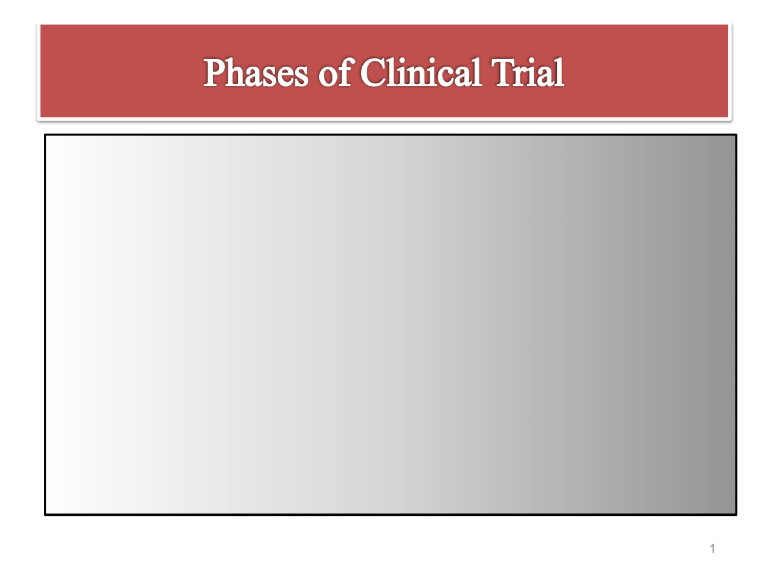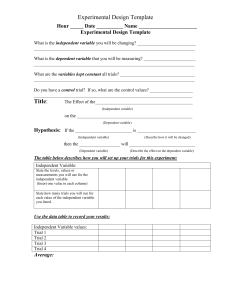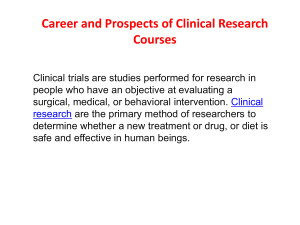
1 1. Introduction 2. Phases of Clinical Trial: a.Phase 0 b. Phase 1 c.Phase 2 d.Phase 3 e.Phase 4 3.Conclusion 4.References 2 Introduction Clinical Trial: Any investigation in human subjects intended to discover or verify the clinical, pharmacological, and other pharmacodynamic effect of an investigational product and to identify any adverse reactions to an investigational product and to study absorption, distribution, metabolism,excretion of an investigational product with the object of ascertaining its safety and efficacy. 3 Clinical trial is a systematic investigation in human subjects for evaluating the safety & efficacy of any new drug. Clinical trials are a set of tests in medical research and drug development that generate safety and efficacy data for health interventions in human beings. Phases of clinical trial 5 Phase 0 Phase 0 is a recent designation for exploratory, first-in-human trials conducted in accordance with the United States Food and Drug Administration's (FDA) 2006 Guidance on Exploratory Investigational New Drug (IND) Studies. Phase 0 trials are also known as human micro dosing studies. Micro dosing helps researchers select better drug candidates for clinical trials by providing early human PK and bioavailability data. 6 Distinctive features of Phase 0 Primary goal:- To assess Pharmacodynamic and Pharmacokinetic particularly oral bioavailability and halflife of the drug. Dose: it is 1/100th of therapeutic dose. Subjects: 10-15 healthy volunteers. A Phase 0 study gives no data on safety or efficacy, being by definition a dose too low to cause any therapeutic effect. Phase 0 clinical trial are not mandatory. They are case to case based. 7 Phase 1 Phase I trials are the first stage of testing in human subjects. Normally, a small group of 20–100 healthy volunteers will be recruited.The duration will be 6-12 months. Phase I trials also normally include dose-ranging, also called dose escalation studies, so that the best and safest dose can be found and to discover the point at which a compound is too poisonous to administer. 8 Distinctive features of Phase 1 Primary goal: To assess the safety (pharmacovigilance), tolerability, pharmacokinetics, and pharmacodynamis of a drug. These trials are often conducted in an inpatient clinic, where the subject can be observed by full-time staff. Phase I trials most often include healthy volunteers. The tested range of doses will usually be a fraction of the dose that caused harm in animal testing. Volunteers are paid an inconvenience fee for their time spent in the volunteer centre. Pay depends on length of participation. 9 Different kinds of phase1 trial Single ascending dose Multiple ascending dose Food effect 10 Phase 2 Once a dose or range of doses is determined, the next goal is to evaluate whether the drug has any biological activity or effect. Phase II trials are performed on larger groups (100-300) and are designed to assess how well the drug works, as well as to continue Phase I safety assessments.The duration will be 6 months to several years. 11 Types of Phase 2 Phase 2a How much drug should be given Phase 2 Phase 2b How well the drug response to the dose 12 Distinctive features of phase 2a Primary goal: To determine the therapeutic efficacy. Pilot trials: Dose response determination, determine dose regimen and determination of target population. Subjects: Few hundreds . Patients fitting narrow eligibility criteria. Trial design: Comparison with baseline status. Open level or single/ double-blind. Dose escalation. Parallel dose response. 13 Distinctive features of Phase 2b Pivotal studies. Objectives: Focus on aspects of phase 2a trial. Blinding. Placebo or other concurrent control. Crossover treatments. Multicenter. Subjects: similar to phase 2a. Trial design: Single or double blinded. Conducted at multiple sites. 14 Phase 3 Phase III studies are randomized controlled multicenter trials on large patient groups (300–3,000 or more depending upon the disease/medical condition studied) and are aimed at being the definitive assessment of how effective the drug is, in comparison with current 'gold standard' treatment. 15 Types of Phase 3 Phase 3a: Subjects: large. Trial design: open level or single or double blinded. Multicenter. Testing different stages of the disease indication. Dosage forms ,formulation Different routes. Pharmacoeconomic evaluation. Phase 3b: Phase III trials will continue while the regulatory submission is pending at the appropriate regulatory agency. This allows patients to continue to receive possibly lifesaving drugs until the drug can be obtained by purchase. i.e. Antiretroviral, Anticancer etc. Peri-approval studies. 16 Phase 4 Phase IV trial is also known as post marketing surveillance Trial. Phase IV trials involve the safety surveillance (pharmacovigilance) and ongoing technical support of a drug after it receives permission to be sold. The safety surveillance is designed to detect any rare or long-term adverse effects over a much larger patient population and longer time period than was possible during the Phase I-III clinical trials. Harmful effects discovered by Phase IV trials may result in a drug being no longer sold, or restricted to certain uses: recent examples involve cerivastatin (brand names Baycol and Lipobay), troglitazone (Rezulin) and rofecoxib (Vioxx). 17 Conclusion Clinical trial may occur in several different phases . Drug are developed in several different phases to meet the multiple objective in the safest, most efficient manner. Phase is only a description and not a set of rules. 18




